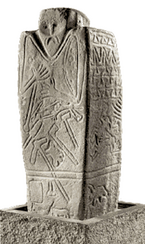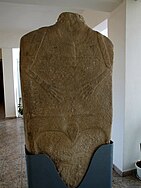
Back Balbal Azerbaijani Kurgaani steel Estonian Statues-menhirs d'Ukraine French אסטלת קורגן HE Stele kurgan Italian Балбал Kazakh Балбал Kirghiz Хүн чулуу Mongolian Koerganstele Dutch Baby kamienne Polish
Kurgan stelae[a] or Balbals (Ukrainian: балбал, most probably from Turkic word balbal meaning "ancestor" or "grandfather"[3]) are anthropomorphic stone stelae, images cut from stone, installed atop, within or around kurgans (i.e. tumuli), in kurgan cemeteries, or in a double line extending from a kurgan. The stelae are also described as "obelisks" or "statue menhirs".
Spanning more than three millennia, they are clearly the product of various cultures. The earliest are associated with the Pit Grave culture of the Pontic–Caspian steppe (and therefore with the Proto-Indo-Europeans according to the mainstream Kurgan hypothesis[4]). The Iron Age specimens are identified with the Scythians and medieval examples with Turkic peoples.
Such stelae are found in large numbers in Southern Russia, Ukraine, Prussia, southern Siberia, Central Asia, Turkey and Mongolia.
- ^ Kovalev, Alexey (2011). "The Great Migration of the Chemurchek People from France to the Altai in the Early 3rd Millenium BCE". International Journal of Eurasian Studies. 1: Figure 31-10.
- ^ Discovered in 1973 in Kernosovka (Kernosivka), Novomoskovsk Raion, Dnipropetrovsk Oblast, Ukrainian SSR, kept in Yavornytsky Historical Museum, Dnipro. JP Mallory, The anthropomorphic stelae of the Ukraine: the early iconography of the Indo-Europeans, Institute for the Study of Man, 1994, 54f.
- ^ O. D. Forostyuk, Луганщина релігійна, Luhansk, Світлиця, 2004.
- ^ David W. Anthony, The Horse, The Wheel and Language: How Bronze-Age Riders from the Eurasian Steppes Shaped the Modern World (2007).
Cite error: There are <ref group=lower-alpha> tags or {{efn}} templates on this page, but the references will not show without a {{reflist|group=lower-alpha}} template or {{notelist}} template (see the help page).



